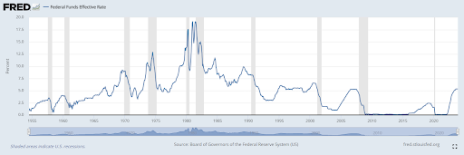Despite bullish starts to 2022 and 2023, the price of gold has been moving in fits and starts for the last two years, seemingly breaking free of the much-cited $2,000/oz level only to retreat as the macroeconomic picture has evolved.
But with the buyers fully in control to start 2024, the evidence suggests that bulls may finally have the upper hand this time around. The combination of a weakening dollar, the possibility of declining yields on fixed-rate assets, and continued (if weakening) inflation is painting a much different picture this time around.
Unlike last year, in which the market fully expected the Fed to continue hiking the Fed Funds rate, there’s now a growing belief that rates are finally going to come down. Indeed, the interest rate futures market is predicting there will be four to six rate cuts in 2024, amounting to a quarter of a percentage point for each cut.
This is an important consideration for gold bulls since the precious metal’s price has tended to benefit from falling interest rates in the last two decades. Conversely, periods when the Fed Funds rate consistently increased were often marked by a struggling gold market.
Board of Governors of the Federal Reserve System (US), Federal Funds Effective Rate [FEDFUNDS], retrieved from FRED, Federal Reserve Bank of St. Louis; https://fred.stlouisfed.org/series/FEDFUNDS, January 18, 2024.
However, it has been pointed out that over the longer term, gold doesn’t always trade inversely vis-à-vis the Fed Funds rate. In the late 1970s, for instance, when interest rates were soaring into the double digits due to runaway inflation, gold had one of its best performances in memory. By contrast, the deflationary period of the credit crisis era also benefited gold.
So, if it isn’t inflation or deflation—and the corresponding rate increases/decreases that accompany it—what is it that ultimately determines a rising price for the metal? In short, it’s anything that potentially threatens the corporate profit outlook.
When investors worry that rapidly increasing inflation will undermine consumers’ ability to spend more, they often hedge their stock holdings by buying gold. On the other hand, when interest rates are declining and there’s a corresponding fear that this indicates a weaker aggregate demand outlook, gold is typically the go-to for participants who want to hedge against that outcome as well.
At the present time, gold has the unique advantage of being bolstered by both lingering inflationary concerns and the prospect of falling interest rates. And as we head into what promises to be an eventful U.S. Presidential election year, gold should further benefit from the economic uncertainty and increased financial market volatility that often accompanies such major election years.
All told, I expect gold to deliver a strong performance in 2024, primarily based on the likelihood that interest rates will reverse in the next several months. If you’re interested in having some exposure to it without actually storing the physical metal, listed gold-backed funds like the GraniteShares Gold Trust (BAR) or the Sprott Physical Gold Trust (PHYS) are good places to start.


